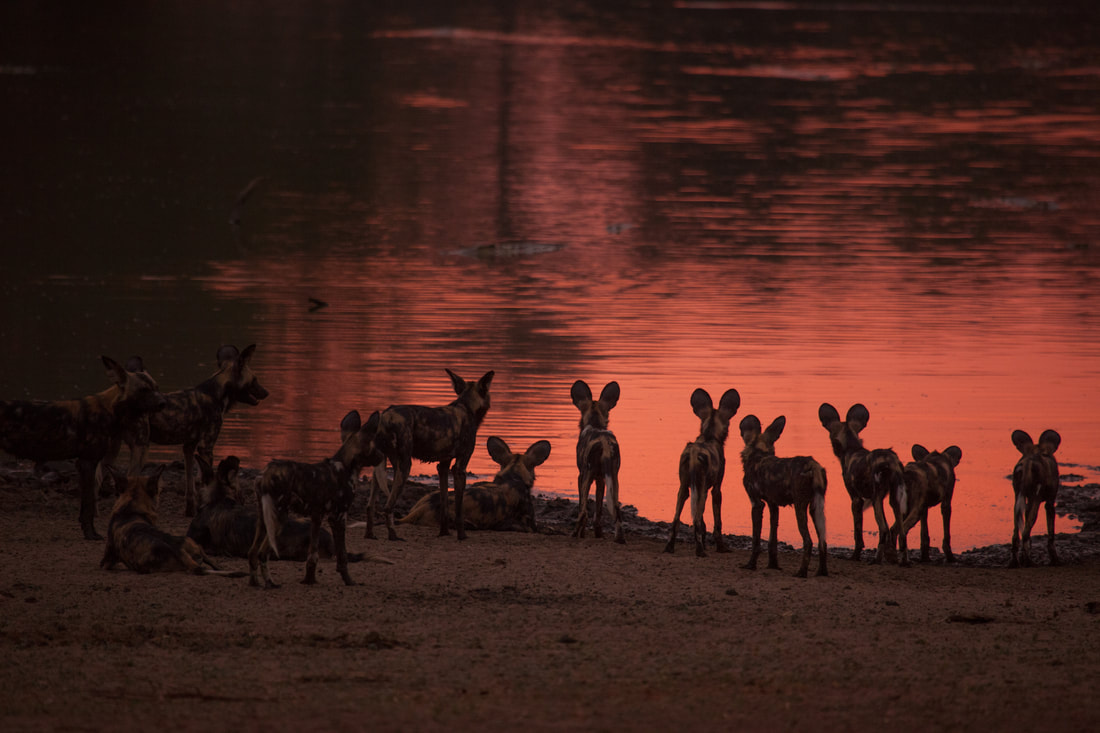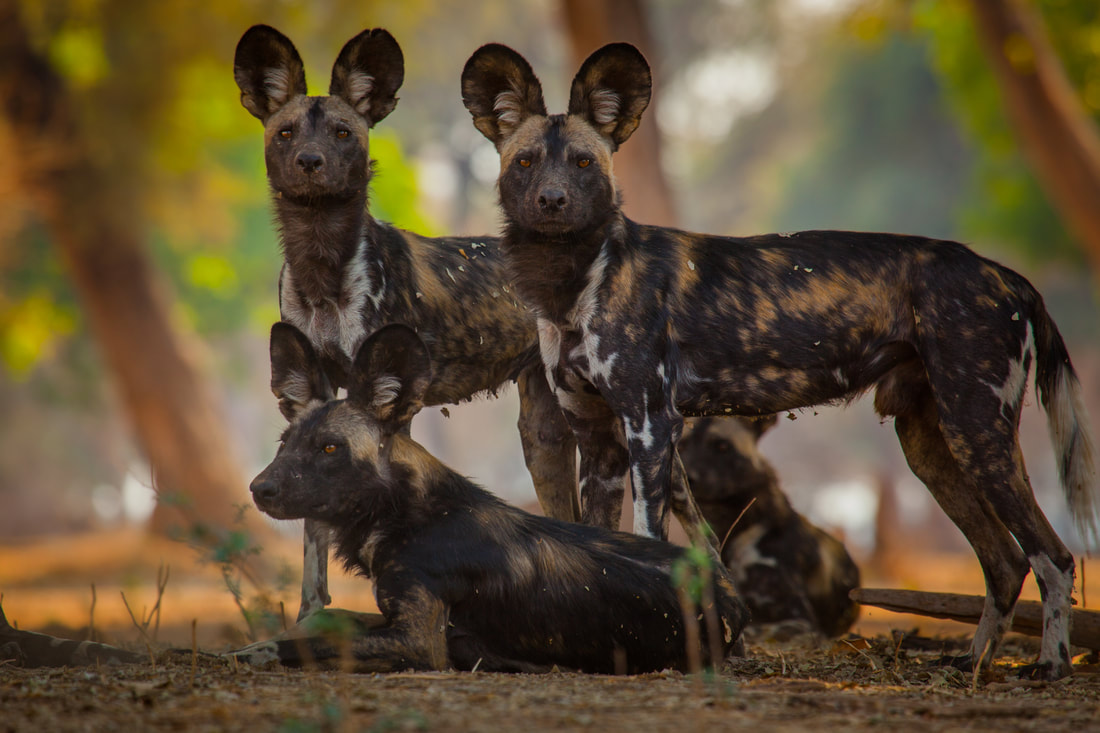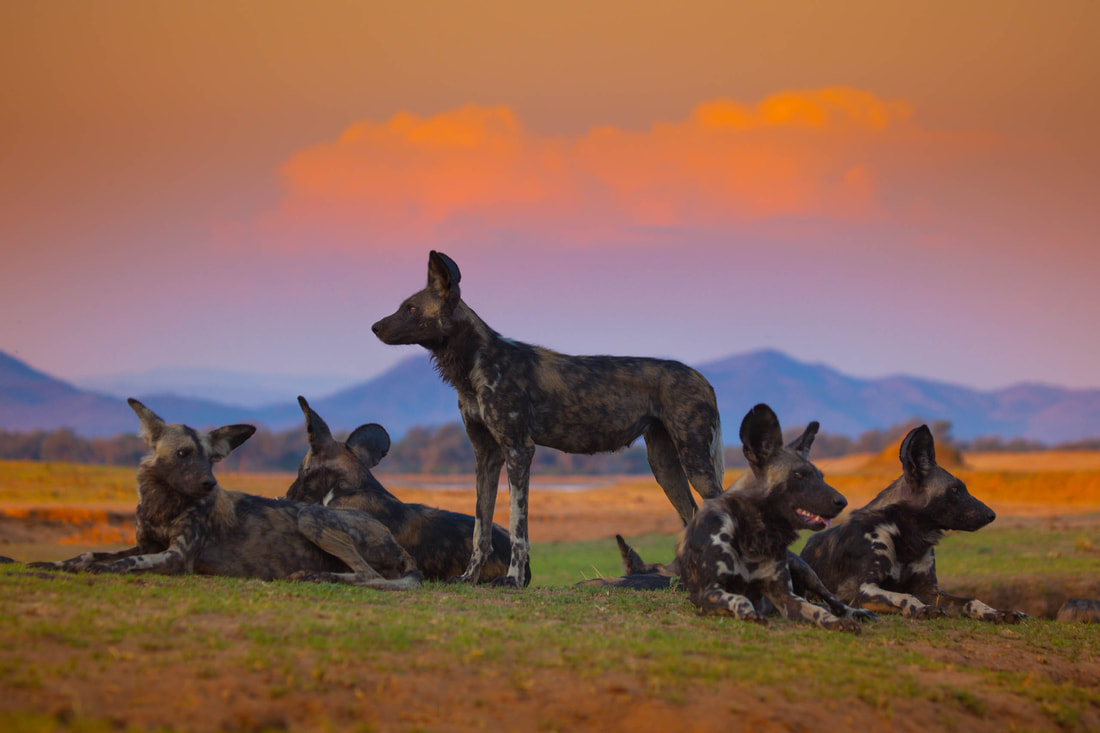|
We reached out to our festival filmmakers to ask them five questions about the experience of making their films.
What inspired this story? Producer, Director and Camera Operator Nick Lyon: When we were looking for a location to film Painted Wolf we knew for this sort of film we wanted there to be a change – something the film could build around – so when we discovered Mana Pools and the amazing backstory of Tait (who our guides had known her entire life) it was clear given her age that she was unlikely to survive to the end of filming – this was enough to know we had some essential building blocks for a film. The presence of three related packs within driving range gave us insurance packs if the worst case scenario happened and the pack collapses (indeed a nearby pack all got poisoned by elephant poachers during our filming). We could never have foreseen the complex interpack story that unfolded in front of us, but our filming approach allowed us to cover what turned out to be a Shakespearean drama. What did you learn from your experience making this film/program? NL: I’m not sure if anyone has followed painted wolves so intensively for such a duration before. I can understand why – it is incredibly hard, there are huge distances involved, and it is easy to lose them in thick scrub, but the more time we spent with them the more we were able to predict their next movements. It got to the point by shoot 8, where the pack would wake up and stretch, and we would race off as they were doing their greeting ceremony and set up cameras 5 kms away ready for the morning hunt. It wouldn’t be long before the whole pack would be bounding past us in full pursuit. They could have gone any direction, 360 degrees from where they woke up, but we had become so tuned to their rhythms and those of the park that we had a feel for what they were doing and when and why. The guides taught us about how slight changes in water level have huge impacts on how they move and navigate their landscape. We found that most of their large movements were dictated by the movement of lions within their ranges, and the more we learned about their fear of lions the bigger we knew Tait’s sacrifice was when she reluctantly led her pack into exile in the pridelands. We also learned that the behavior of painted wolves can vary massively from location to location. I would be reading scientific literature which made broad sweeping claims about these animals that just didn’t ring true in Mana Pools. I think it is fair to say that from place to place packs pass down different “cultures” that are appropriate to the diverse habitat types they are found in. The received wisdom is that painted wolves do not hunt baboons, furthermore on balance even predators such as leopards are thought to actively avoid hunting baboons, however we recognized a big shift in behaviour during our filming period. Whilst there had been the odd, sporadic sighting of the packs taking baboons, it was very much the exception, until 6 months into filming where suddenly we noticed lots of baboon body parts being brought back to Blacktip’s den, and the slightly gory sight of cute puppies playing tug of war with baboon arms, or “football” with baboon heads. They started off being small individuals, but as time went on we started to see them hunting baoons on the floodplain (wereas previously they had been hunting them in the thick brush of the backcountry). The baboons they targeted got bigger over time as they refined their hunting techniques. The alarm calls of the baboons also started to change. They started with a warning call for leopards (that was quite furious) and a totally different call for lesser threat predators – they did the same call for the painted wolves as they did for the lions. After the baboon-hunting began the baboons started using their leopard alarm for the painted wolves. Sometimes this would see whole groups of baboons emptying out of the trees to avoid being ambushed in the branches, only to fall prey to a pack of 30 painted wolves. It would be interesting to know if since then they have developed a unique call for the painted wolves. This baboon alarm call spread down the floodplain over the next year, and then again when animals dispersed from Blacktip’s pack and joined Tammy’s pack we saw the baboon hunting behavior move with them and get passed on to the other pack members. We had so many baboon hunting records on our cameras that it provided close to 80% of the statistical data of a paper I co-authored with zoologist Esther van der Meer on active selection of baboons by painted wolves. For reference: research paper "Dangerous game: preferential predation on baboons by African wild dogs in Mana Pools National Park, Zimbabwe" linked here.
How do you approach storytelling?
NL: With this film in particular – starting as we did with 3 different packs, and covering in our time 91 different individual painted wolves, we had a big challenge. Because we were committed to telling the truth “warts and all” – we didn’t know who would rise or fall in the period of filming, and there were many surprises along the way, that would have been real curveballs if we had focused our attention on fewer individuals too soon in the process. So we approached the storytelling like an observational documentarian would with a people story, building numerous backstories and getting footage of all the animals so that as we recognised who would be the important players, decision makers, the rising alphas, we could go back through the rushes to tease out these individual’s stories. We then had the challenge of fitting in sequences that involved wonder, spectacle, behavior and insight at the same time as keeping the audience on track with a developing narrative of two distinct, but related and interacting packs. At one point we had a board of 60 possible landmark quality sequences on post its, and had to really work hard to keep the central themes going, stick to the correct chronology and make sure all our named animals were the correct animals – it was quite a challenge. What impact do you hope this film/program will have? NL: I felt going into this film that I was dealing with the underdog of the series – the one that was least known and most misunderstood. My hope was that by the end of this film not only would people know what a painted wolf was – but that I may become their new favourite animal – and this has certainly been a lot of the feedback I have received on social media. I have also had the opportunity to speak about the filmmaking process, co-author a scientific paper, and engage the audience with the plight of this species. Working in collaboration with an incredible artist in the UK - Emily Lamb - her paintings of my photos are now pulling in funds for frontline conservation of this species and more. Were there any surprising or meaningful moments/experiences you want to share? NL: We had a panic early in the filming process, where Tait suddenly and inexplicably disappeared. We saw her pack so knew they hadn’t just moved to a different area (which can happen), but Tait would never have gone off by herself so after a week we began to fear the worse. We did, however, notice that the pack never rested on the floodplain during the day after their hunt, which outside of puppy time was their normal behavior. They kept running back into the back country away from the river after their morning hunt – typical of their denning behaviour. We realized that they must have Tait holed up somewhere; and they were clearly going back to feed her, regurgitating meat from their hard earned hunt for their beloved leader. Sure enough, after 2 weeks of absence, an older and more worn Tait re-appeared. We’re not sure what happened to her, but it was clear her pack looked after her and nursed her back to health. She was never quite the same after this moment, but even in her weakened state their was never a challenge to her leadership, the pack really loved her, and from then on we frequently saw different members of the pack regurgitating food for her. It is a rare thing to see in the natural world and I found the relationships between pack members very moving. Any fun facts about the film/program, the subject matter or the production crew that might surprise the audience? NL: We spent 669 days in the field. To follow the packs we drive 51,000 miles. In a single wet season shoot we had 22 punctures. We did 60 nights of following the packs after dark with thermal cameras. We recorded 313 hours of “selects” – the high quality footage that could have made it into the show. We worked with 9 professional guides and 9 specialist camera operators. The working day was normally 03:30 to 22:30, and the heat of the day was often spent snoozing in a sandy river bed near our packs, obviously being mugged by sweat bees! Anything else you would like people to know? NL: There has been some feedback from the scientific community that there are moments in the film that “anthropomorphise” the characters. It is an interesting, but broadly outdated, concept. Anthropomorphism is understood as ascribing human-like characteristics to animals – but is largely based on the cultural construction of an arbitrary human-animal divide. Research and understanding have progressed in such a way that the whole human-animal divide has been blurred and we are very much recognized as human animals. Many of the traits perceived to be peculiar to humans have been found present in animals, ranging from tools use, theory of mind, teaching and language. Those of us who have spent serious amounts of time studying and filming animals in the wild, or even owning pets know that emotions are not a peculiar to the human condition, and we are just one of many animals to experience emotions. With that in mind I would like to say that we worked very carefully on this film to ascribe reactions to these animals that we truly believed them to be having and not, as some have accused us of, made up to create a more compelling story. I think it is important that we don’t hamstring ourselves in the telling of true stories by fear of being accused of anthropomorphism – it is a dangerous construct that I believe bolsters exploitation of the natural world and individual wild animals and domestic animals, and that is our philosophical and ethical duty to represent the truth, and not be swayed by hidden agendas of those who would attempt to discredit us in the process.
0 Comments
Leave a Reply. |
Archives
March 2024
Categories
All
|
Contact UsJackson Wild
240 S. Glenwood, Suite 102 PO Box 3940 Jackson, WY 83001 307-200-3286 info@jacksonwild.org |




 RSS Feed
RSS Feed